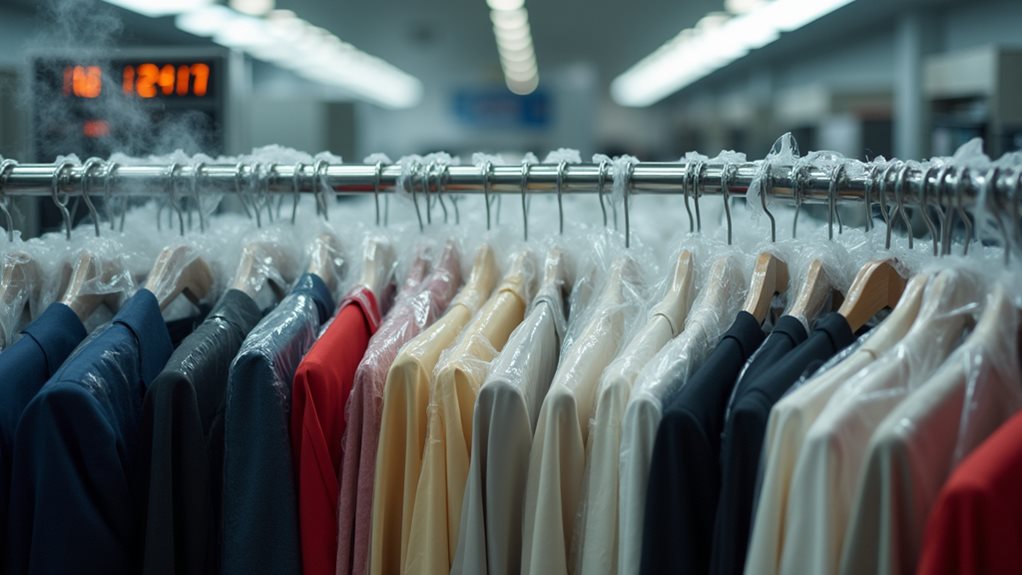When you’re wondering about dry cleaning timelines, you’ll typically wait 1-2 days for standard items like dress shirts and basic trousers, though I’ve learned the hard way that delicate fabrics and formal wear can stretch that timeline to 3-5 days or even a week. Wedding dresses and heavily soiled garments often need special attention that extends processing time considerably, especially during busy holiday periods when everyone’s rushing to get their clothes cleaned. There’s much more to ponder about timing factors.
The Dry Cleaning Process and How It Affects Turnaround Time
When I first started using dry cleaning services, I honestly thought it was some kind of magical process where clothes disappeared into a mysterious back room and emerged pristine hours later – boy, was I wrong! 😅
The reality is that dry cleaning involves five distinct steps that each play a crucial role in determining how long you’ll be waiting to get your favorite blazer back. First comes drop-off and inspection, where professionals examine your garments for stains and fabric requirements.
Then there’s the actual cleaning process, followed by pressing, and finally quality control. Standard clothing items typically move through these stages seamlessly, but delicate garments requiring specialized care can greatly extend turnaround times, sometimes doubling your wait. The dry cleaner’s equipment capacity also significantly impacts processing times, as facilities with more advanced or numerous machines can handle larger volumes more efficiently.
How Long Does Dry Cleaning Take for Different Garments?

Ever wondered why your favorite cashmere sweater takes so much longer at the dry cleaner than your everyday work shirt? The truth is, different garments that take longer require varying levels of special care, and understanding these cleaning times can help you plan better.
Delicate fabrics and intricate garments demand more time and specialized attention than basic clothing items at the dry cleaner.
Here’s what you can expect for turnaround time:
- Standard clothing items like dress shirts and basic trousers typically take 1-2 days.
- Delicate fabrics with intricate details need 3-4 days or more for proper handling.
- Large items such as comforters can take up to a week.
When it comes to formal suits, expect around 3-5 days, while that precious wedding dress can take anywhere from several days to weeks.
The dry cleaning process doesn’t take really long without reason—quality cleaning for certain garments simply requires patience. Busy periods like wedding seasons may extend normal processing times beyond these typical estimates.
Factors That Can Extend Your Dry Cleaning Wait Time

Although you might assume your dry cleaning will follow that standard timeline we just discussed, several sneaky factors can throw a wrench into your perfectly planned schedule.
Trust me, I’ve learned this the hard way after showing up to pick up my suit the day before a wedding only to find it wasn’t ready.
Peak times like holidays dramatically increase processing times because everyone’s scrambling to look their best.
Complex garments with beading or delicate fabrics need additional time for special care, while extremely soiled clothes require extra treatment cycles.
Staff limitations during busy periods slow everything down, and dropping off items during rush hours extends wait times.
Items like wedding dresses or leather goods may require 5-7 days or longer due to their delicate nature and specialized cleaning requirements.
Understanding these variables helps you plan better and avoid my last-minute panic 😅.
Items That Cannot Be Dry Cleaned

Beyond timing complications, you’ll want to know that some items simply can’t handle the dry cleaning process at all, and I discovered this the expensive way when I ruined my grandmother’s vintage fur stole by taking it to the wrong cleaner.
The harsh solvents that dry cleaners use can strip natural oils from delicate fabrics, causing irreversible damage to your precious clothing items.
Chemical treatments can permanently alter fabric structure, leaving your favorite garments damaged beyond repair.
Here are three categories that require special attention:
- Fur garments and leather specialized cleaning – These need gentle, moisture-based treatments that preserve their natural characteristics.
- Suede sensitive cleaning materials – Professional dry cleaning solvents can alter their texture permanently.
- Heavy beading embellishments – Decorative elements often get damaged during cleaning cycles.
Premium down jackets like Canada Goose should also avoid dry cleaning, as the chemicals can strip natural oils from feathers and reduce their insulating properties.
Always check care instructions before assuming professional dry cleaning is safe!
Proper Ways to Store Dry-Cleaned Items

When you finally get your freshly dry-cleaned clothes back home, the way you store them can make the difference between garments that last for years and ones that deteriorate within months, something I learned after finding my favorite blazer covered in mysterious yellow spots because I’d left it wrapped in plastic for too long.
Now I always store dry-cleaned items in a cool dry place using breathable garment bags instead of those flimsy plastic covers. This simple switch helps prevent moisture buildup that ruins expensive fabrics.
I also avoid hanging heavy garments on wire hangers, choosing padded ones to maintain shape and structure. For delicate fabrics like silk, I’m storing flat with acid-free tissue paper, and I keep garments away from sunlight.
Additionally, I ensure proper ventilation in the storage area when bringing home items cleaned with traditional solvents, as chemical solvents can linger on fabrics and benefit from air circulation before long-term storage.




